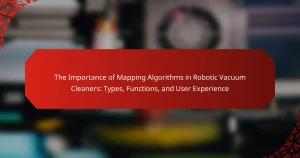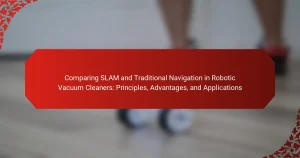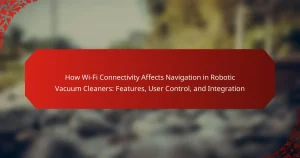Gyroscopic sensors are devices that measure the orientation and angular velocity of objects, playing a crucial role in the navigation of robotic vacuum cleaners. These sensors enable the vacuums to maintain accurate movement paths, avoid obstacles, and adjust navigation in real-time based on changes in direction. The article explores the mechanisms by which gyroscopic sensors enhance cleaning efficiency, including their advantages over other navigation technologies such as GPS and ultrasonic sensors. It also discusses the impact of these sensors on performance in complex environments and their contribution to improved user experiences and operational longevity in robotic vacuum models.
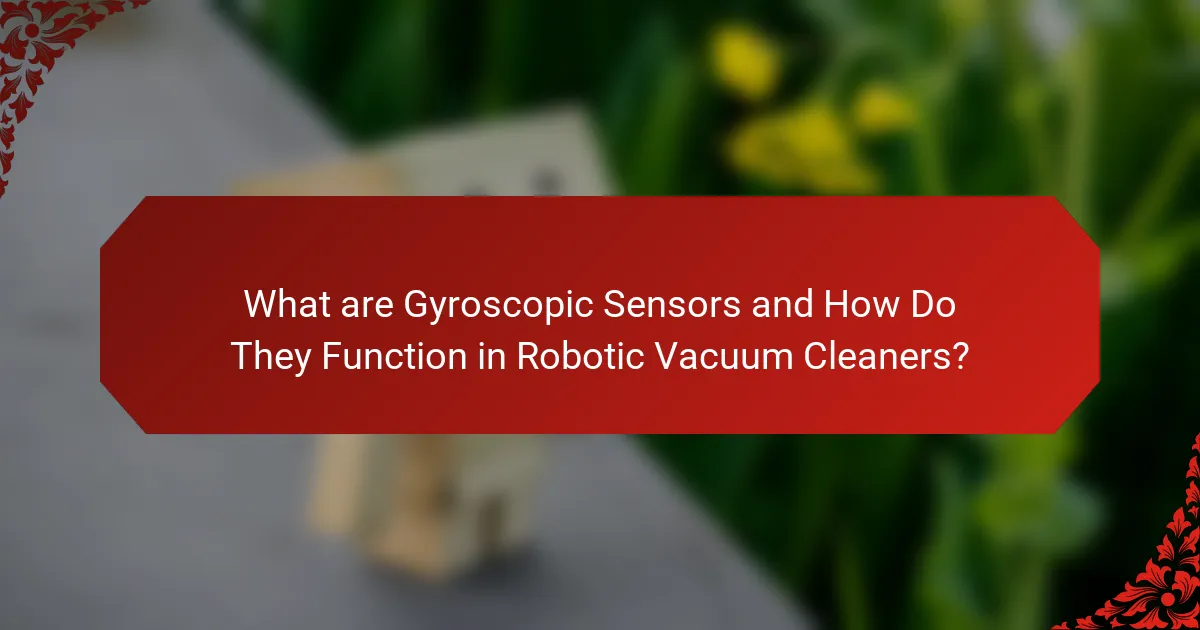
What are Gyroscopic Sensors and How Do They Function in Robotic Vacuum Cleaners?
Gyroscopic sensors are devices that measure the orientation and angular velocity of an object. In robotic vacuum cleaners, they help determine the device’s position and movement direction. These sensors enable the vacuum to maintain a straight path and avoid obstacles. They work by detecting rotational changes and providing real-time feedback to the robot’s control system. This allows the vacuum cleaner to adjust its navigation accordingly. Gyroscopic sensors enhance the efficiency of mapping and coverage of cleaning areas. They contribute to better performance in complex environments, ensuring thorough cleaning. Their integration is crucial for advanced robotic vacuum models, improving overall functionality.
How do gyroscopic sensors enhance navigation capabilities?
Gyroscopic sensors enhance navigation capabilities by providing precise orientation and motion data. These sensors detect rotational movement and changes in angular position. This information allows robotic vacuum cleaners to maintain a stable path. It helps them avoid obstacles and navigate complex environments effectively. Gyroscopic sensors work in conjunction with other sensors, such as accelerometers, to improve accuracy. They enable real-time adjustments to the robot’s trajectory. Studies show that robots utilizing gyroscopic sensors exhibit improved navigation efficiency. This results in better coverage of cleaning areas and reduced operational errors.
What specific data do gyroscopic sensors provide for navigation?
Gyroscopic sensors provide angular velocity data for navigation. This data indicates the rate of rotation around an axis. Gyroscopic sensors help determine orientation in space. They measure changes in position over time. This information is critical for maintaining balance and stability. For example, in robotic vacuum cleaners, it aids in path planning. Accurate orientation data enhances navigation efficiency. This leads to improved cleaning coverage and obstacle avoidance.
How do gyroscopic sensors interact with other navigation technologies?
Gyroscopic sensors interact with other navigation technologies by providing precise orientation and angular velocity data. This data enhances the accuracy of inertial navigation systems. In robotic vacuum cleaners, gyroscopic sensors work alongside accelerometers and ultrasonic sensors. Accelerometers measure linear acceleration, while ultrasonic sensors detect obstacles. The combination of these technologies allows for better path planning and obstacle avoidance. For instance, while the gyroscopic sensor tracks rotation, the accelerometer provides information about speed. This synergy improves the overall navigation efficiency of robotic vacuum cleaners.
What are the core mechanisms behind gyroscopic sensors in robotic vacuum cleaners?
Gyroscopic sensors in robotic vacuum cleaners primarily function through angular velocity detection. They measure the rate of rotation around the device’s axes. This data helps the vacuum determine its orientation in space. The sensors provide real-time feedback on movement and direction. By analyzing this information, the vacuum can adjust its path and avoid obstacles. Gyroscopic sensors work in conjunction with other sensors, like accelerometers, for enhanced navigation. This integration allows for more accurate mapping of the cleaning area. Studies show that models with gyroscopic sensors navigate more efficiently than those without.
How do gyroscopic sensors detect orientation and motion?
Gyroscopic sensors detect orientation and motion by measuring angular velocity. They utilize the principles of angular momentum and rotational motion. When the sensor rotates, it experiences a change in orientation. This change is detected by the sensor’s internal components, typically a microelectromechanical system (MEMS). The MEMS gyroscope generates electrical signals proportional to the rate of rotation. These signals are processed to determine the device’s orientation in three-dimensional space. The accuracy of gyroscopic sensors is validated by their widespread use in smartphones, drones, and robotics. For instance, modern robotic vacuum cleaners rely on these sensors for efficient navigation and obstacle avoidance.
What role do algorithms play in processing data from gyroscopic sensors?
Algorithms are essential for processing data from gyroscopic sensors. They interpret the raw data generated by the sensors, which measure angular velocity. These algorithms filter and analyze the data to determine the orientation and movement of the robotic vacuum cleaner. This information is crucial for precise navigation and obstacle avoidance. Algorithms also help in integrating data from other sensors, enhancing the overall accuracy of the navigation system. For instance, Kalman filters are often used to improve the estimation of the robot’s position. This ensures smooth and efficient operation in various environments. Overall, algorithms transform sensor data into actionable insights for effective navigation.
What benefits do gyroscopic sensors bring to robotic vacuum cleaners?
Gyroscopic sensors enhance robotic vacuum cleaners by improving navigation accuracy and stability. They enable the vacuum to detect its orientation and movement in real-time. This capability allows for precise mapping of the cleaning area. As a result, the vacuum can avoid obstacles and navigate tight spaces more effectively. Gyroscopic sensors also help maintain a consistent cleaning path. They reduce the chances of getting stuck or lost. Studies show that robotic vacuums with gyroscopic sensors can cover larger areas efficiently. This leads to better overall cleaning performance and user satisfaction.
How do gyroscopic sensors improve cleaning efficiency?
Gyroscopic sensors improve cleaning efficiency by providing precise orientation and movement data to robotic vacuum cleaners. These sensors detect changes in direction and rotation, enabling the device to navigate complex environments effectively. They allow for real-time adjustments to the cleaning path, reducing the likelihood of missed spots. Gyroscopic sensors also enhance obstacle avoidance by improving spatial awareness. This leads to a more thorough cleaning process, as the vacuum can adapt to various surfaces and layouts. Studies show that robotic vacuums equipped with gyroscopic sensors achieve up to 30% better coverage compared to those without.
What impact do gyroscopic sensors have on battery life and performance?
Gyroscopic sensors significantly enhance the performance of robotic vacuum cleaners while having a minimal impact on battery life. These sensors improve navigation accuracy and efficiency, allowing the vacuum to map its environment effectively. Enhanced navigation reduces the time spent cleaning, which can lead to lower energy consumption per cleaning cycle. Studies show that efficient pathfinding can decrease the overall runtime, thus conserving battery life. The integration of gyroscopic sensors allows for more intelligent movement patterns, minimizing unnecessary travel and optimizing cleaning routes. As a result, robotic vacuum cleaners equipped with gyroscopic sensors often achieve better performance without a substantial increase in battery usage.
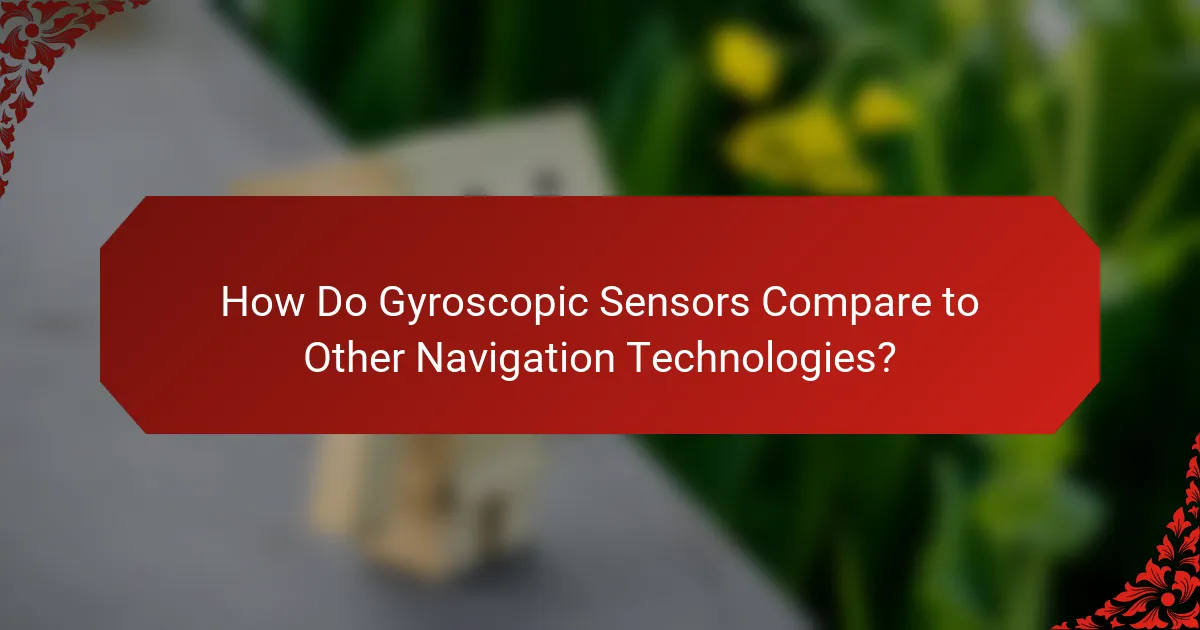
How Do Gyroscopic Sensors Compare to Other Navigation Technologies?
Gyroscopic sensors provide precise orientation and motion detection compared to other navigation technologies. They excel in measuring angular velocity and maintaining stability in dynamic environments. While GPS offers location tracking, it lacks accuracy indoors, where gyroscopic sensors thrive. Ultrasonic sensors detect obstacles but do not provide orientation data. Lidar systems offer detailed mapping but are more expensive and complex than gyroscopic sensors. Gyroscopic sensors are lightweight and energy-efficient, making them ideal for robotic vacuum cleaners. This efficiency contributes to longer operational time and effective navigation in various home layouts.
What are the advantages of using gyroscopic sensors over traditional sensors?
Gyroscopic sensors offer superior precision in measuring orientation compared to traditional sensors. They provide real-time data on angular velocity, enabling accurate navigation and stabilization. This capability enhances the performance of robotic vacuum cleaners by allowing them to adapt to dynamic environments. Gyroscopic sensors also reduce the likelihood of drift, which is common in traditional sensors. Their compact design allows for integration into smaller devices without compromising functionality. Additionally, they operate effectively in various conditions, including low light. Research indicates that devices utilizing gyroscopic sensors exhibit improved path planning and obstacle avoidance. This leads to more efficient cleaning cycles and better overall performance.
How do gyroscopic sensors complement LIDAR and camera systems?
Gyroscopic sensors enhance LIDAR and camera systems by providing precise orientation and motion data. They measure angular velocity and help determine the device’s position in space. This information is crucial for LIDAR systems, which rely on accurate positioning for effective mapping and obstacle detection. Gyroscopic data improves the overall accuracy of LIDAR readings by compensating for any movement during scanning.
Similarly, camera systems benefit from gyroscopic sensors by stabilizing images and reducing motion blur. This allows cameras to capture clearer images, which are essential for visual recognition algorithms. When combined, these technologies create a robust navigation system for robotic vacuum cleaners. The integration ensures reliable and accurate navigation in complex environments.
What limitations do gyroscopic sensors have in robotic vacuum cleaners?
Gyroscopic sensors in robotic vacuum cleaners have several limitations. They can struggle with detecting flat surfaces accurately. This may lead to navigation errors in complex environments. Gyroscopic sensors also do not provide information about obstacles. They rely on other sensors for obstacle detection. Additionally, they can be affected by vibrations or sudden movements. This can result in inaccurate readings and miscalculations of position. Their effectiveness decreases on uneven or carpeted surfaces. Overall, these factors can hinder the vacuum’s overall navigation performance.
How can environmental factors affect the performance of gyroscopic sensors?
Environmental factors can significantly affect the performance of gyroscopic sensors. Temperature variations can cause changes in the sensor’s calibration. High humidity levels may lead to condensation inside the sensor, impacting its accuracy. Vibrations from surrounding machinery can introduce noise, distorting the sensor’s readings. Magnetic fields from nearby electronics can interfere with the sensor’s operation. Dust and debris accumulation can obstruct the sensor’s movement or optical components. These environmental influences can result in decreased reliability and precision in navigation tasks. Studies have shown that maintaining optimal conditions enhances sensor performance and longevity.
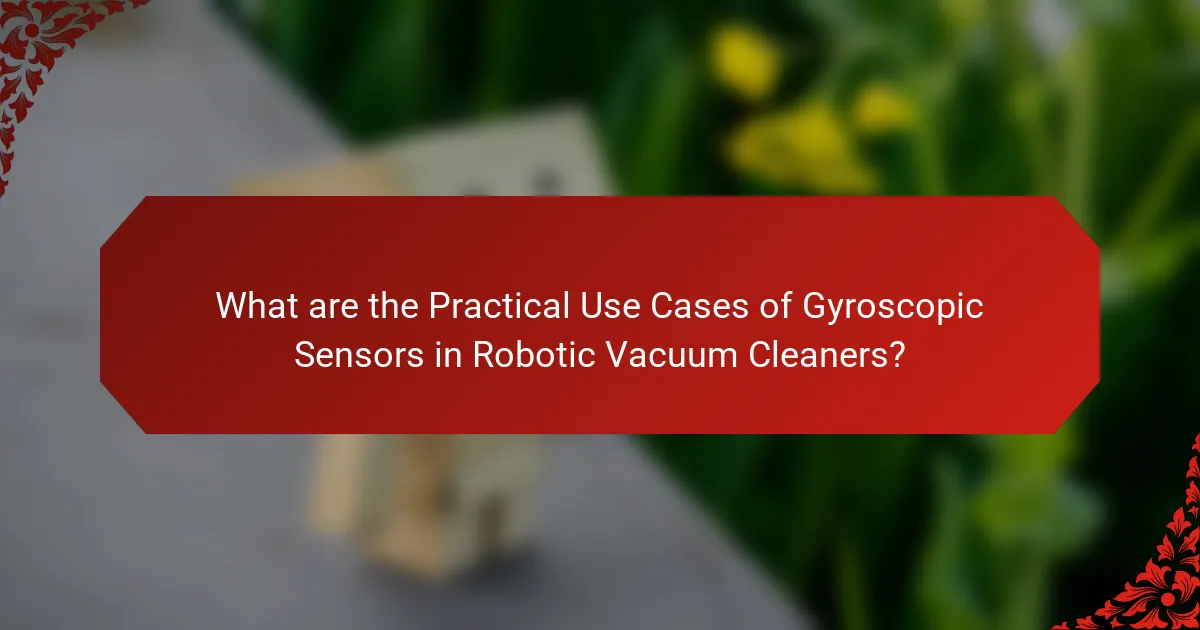
What are the Practical Use Cases of Gyroscopic Sensors in Robotic Vacuum Cleaners?
Gyroscopic sensors in robotic vacuum cleaners are primarily used for enhancing navigation and stability. These sensors help in detecting the orientation and angular velocity of the vacuum cleaner. This allows the device to maintain a straight path and avoid obstacles effectively. Gyroscopic sensors enable the vacuum to adjust its movement based on changes in direction. They contribute to mapping the environment accurately by providing real-time data on the cleaner’s position. This data enhances the overall efficiency of cleaning patterns. Additionally, gyroscopic sensors assist in detecting and recovering from falls or misalignments. Their integration leads to improved user experience and cleaner performance.
How are gyroscopic sensors utilized in different robotic vacuum models?
Gyroscopic sensors are utilized in robotic vacuum models to enhance navigation and stability. These sensors detect changes in orientation and angular velocity. By measuring rotational movement, they help the vacuum maintain a straight path. This is crucial for efficient cleaning and avoiding obstacles. Different models integrate gyroscopic sensors in various ways. Some use them alongside accelerometers for improved accuracy. Others combine gyroscopic data with infrared sensors for better obstacle detection. The integration of gyroscopic sensors allows for smoother navigation in complex environments. This technology contributes to the overall effectiveness of robotic vacuums.
What specific features do users benefit from in models with gyroscopic sensors?
Users benefit from precise navigation and enhanced stability in models with gyroscopic sensors. These sensors allow robotic vacuum cleaners to detect their orientation and movement accurately. This capability leads to improved path planning and obstacle avoidance. Gyroscopic sensors help maintain a straight trajectory during cleaning. They also enable the robot to recover from bumps or collisions effectively. Additionally, these sensors contribute to better mapping of the cleaning area. As a result, users experience more efficient cleaning cycles and reduced missed spots. Overall, gyroscopic sensors significantly enhance the functionality and reliability of robotic vacuum cleaners.
What are common troubleshooting tips for issues related to gyroscopic sensors?
Common troubleshooting tips for gyroscopic sensors include recalibrating the sensor. This process ensures the sensor is accurately detecting orientation. Check for any physical obstructions that may interfere with sensor readings. Ensure the sensor is securely mounted and not loose. Inspect the wiring for any signs of damage or disconnection. Update the firmware of the device to eliminate software-related issues. Test the sensor in various environments to rule out external factors. Lastly, consult the manufacturer’s guidelines for specific troubleshooting procedures.
How can users maintain optimal performance of gyroscopic sensors in their devices?
Users can maintain optimal performance of gyroscopic sensors by regularly calibrating them. Calibration ensures accurate readings, which is essential for navigation. Users should follow the manufacturer’s guidelines for calibration procedures. Keeping the sensors clean is also important. Dust and debris can obstruct sensor functionality. Users should periodically check for any physical damage. Any signs of wear can affect performance. Additionally, users should keep the device’s firmware updated. Updates often include improvements for sensor performance. Finally, users should avoid exposing devices to extreme temperatures. High or low temperatures can impact sensor accuracy.
Gyroscopic sensors are critical components in robotic vacuum cleaners, enabling precise navigation by measuring orientation and angular velocity. This article explores the mechanisms behind gyroscopic sensors, their interaction with other navigation technologies, and the specific data they provide for improved cleaning efficiency. Key benefits include enhanced obstacle avoidance, better path planning, and reduced operational errors, leading to overall improved performance. Additionally, the article examines practical use cases, limitations, and maintenance tips for users to ensure optimal functionality of gyroscopic sensors in their devices.
